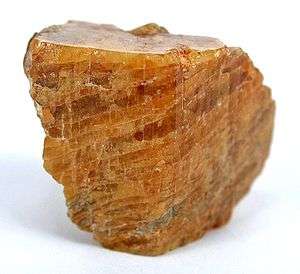Simpsonite
| Simpsonite | |
|---|---|
|
Locality: Alto do Giz pegmatite, Rio Grande do Norte, Brazil. Size: 1.6 x 1.5 x 1.8 cm. | |
| General | |
| Category | Oxide minerals |
| Formula (repeating unit) | Al4(Ta,Nb)3O13(OH) |
| Strunz classification | 4.DC.10 |
| Crystal system | Trigonal |
| Crystal class |
Pyramidal (3) H-M symbol: (3) |
| Space group | P3 |
| Unit cell | a = 7.37, c = 4.51 [Å]; Z = 1 |
| Identification | |
| Formula mass | 813.65 g/mol |
| Color | White to cream, yellow to yellow-brown when altered |
| Crystal habit | Euhedral, prismatic, striated |
| Cleavage | None |
| Fracture | Conchoidal |
| Tenacity | Brittle |
| Mohs scale hardness | 7-7.5 |
| Luster | Vitreous to adamantine |
| Streak | White |
| Diaphaneity | Semitransparent |
| Specific gravity | 6.7 |
| Optical properties | Uniaxial negative |
| Refractive index | nω = 2.045 nε = 2.025 |
| Birefringence | δ = 0.020 |
| Other characteristics | Blue-white cathodoluminescence and yellow fluorescence in SW UV |
| References | [1][2][3][4] |
Simpsonite has a general formula of Al4(Ta,Nb)3O13(OH). It occurs as euhedral to subhedral tabular to short and prismatic crystals, commonly in subparallel groups. Under the petrographic microscope it has a very high relief.
Discovered in 1938, it was named after Edward Sydney Simpson (1875–1939), government mineralogist and analyst of Western Australia.[3] It is an accessory mineral in some tantalum-rich granite pegmatites. It occurs in association with tantalite, manganotantalite, microlite, tapiolite, beryl, spodumene, montebrasite, pollucite, petalite, eucryptite, tourmaline, muscovite and quartz.[1] It is found in a few locations around the world, notably in the Onca and Paraiba mines of Rio Grande do Norte, Brazil and at Tabba Tabba, Western Australia.[1]
References
- 1 2 3 Handbook of Mineralogy
- ↑ Webmineral data
- 1 2 Simpsonite: Mindat.org
- ↑ Philonen, P.C., Grew, E.S., Ercit, T.S., Roberts, A.C., Jambor, J.L. (2005) New mineral names. American Mineralogist, 90, 1227-1233
| Wikimedia Commons has media related to Simpsonite. |
